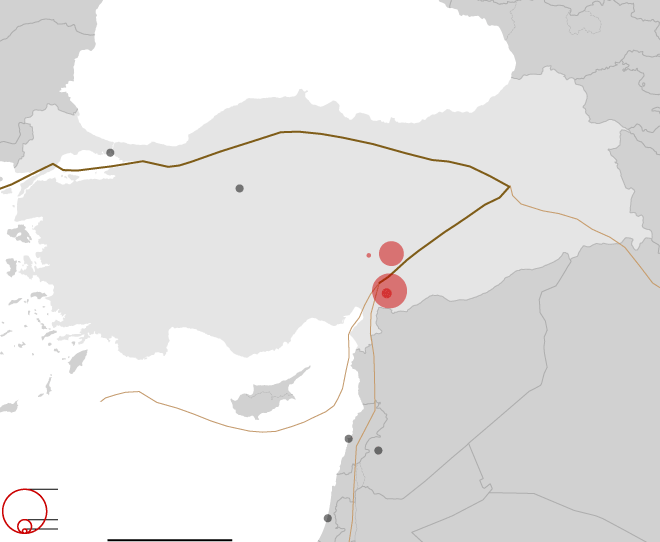
How Turkey’s Anatolian Fault System Causes Devastating Earthquakes
The major earthquake and large aftershock in Turkey on Monday are two of more than 70 quakes of magnitude 6.5 or higher recorded in the region since 1900. Turkey’s two main fault zones — the East Anatolian and the North Anatolian — make it one of the most seismically active regions in the world.
Map showing the East Anatolian and North Anatolian fault zones in Turkey. Points are overlaid on the map showing the locations of major earthquakes in the region since 1900.
Eurasian
Plate
Bulgaria
North Anatolian
Fault
Istanbul
Ankara
Iran
Turkey
East Anatolian
Fault
Feb. 6
Gaziantep
Anatolian Plate
Greece
Arabian Plate
Syria
Iraq
Beirut
Earthquake
magnitude
Damascus
African Plate
8
7
200 miles
6
Eurasian Plate
North Anatolian
Fault
Istanbul
Ankara
Turkey
East Anatolian
Fault
Feb. 6
Anatolian Plate
Arabian Plate
Syria
Iraq
Earthquake
magnitude
Beirut
Damascus
8
Tel Aviv
7
200 miles
6
Sources: National Oceanic and Atmospheric Administration; United StatesGeological Survey Notes: Includes earthquakes since 1900 that are classified as significant earthquakes by the National Centers for Environmental Information based on a series of criteria including deaths, damage and magnitude.
The 7.8-magnitude earthquake at 4:17 a.m. local time, and the unusually large 7.5-magnitude aftershock nine hours later, both were in the East Anatolian Fault Zone. But there have been several extremely deadly quakes in the North Anatolian Fault Zones as well, including one in 1999 about 60 miles from Istanbul that killed about 17,000 people.
These fault zones are a result of movement of large portions of Earth’s crust, or tectonic plates, relative to each other. One zone includes the Anatolian Plate, which makes up most of Turkey. The East Anatolian zone encompasses the area where there is movement of the Anatolian Plate relative to the Arabian Plate to the southeast. The North Anatolian zone is where there is movement of the Anatolian Plate and the Eurasian Plate to the north.
The main quake on Monday was one of the most powerful earthquakes ever recorded in the area, matching the magnitude of a earthquake that killed about 30,000 people in December 1939 in northeast Turkey.
Chart showing year and the number of deaths in earthquakes.
Magnitude
1900
1920
1940
1960
1980
2000
2023
4
5
6
7
8
turkey, 1939
Magnitude
7.7
Est. deaths
32,700
armenia, 1988
Magnitude
6.8
Est. deaths
25,000
turkey, 1999
Magnitude
7.6
Est. deaths
17,118
turkey, 2023
Magnitude
7.8
Est. deaths
3,800
as of 5 p.m. E.T. on Feb. 6
Sources: National Oceanic and Atmospheric Administration; United States Geological Survey Notes: Major earthquakes are those classified as significant earthquakes by the National Centers for Environmental Information based on a series of criteria, including deaths, damage and magnitude. Death tolls are estimates and are approximately assigned to the related event.
……Read full article on The New York Times-World
Earthquake
Comments
Leave a comment in Nestia App